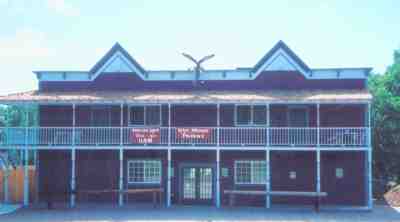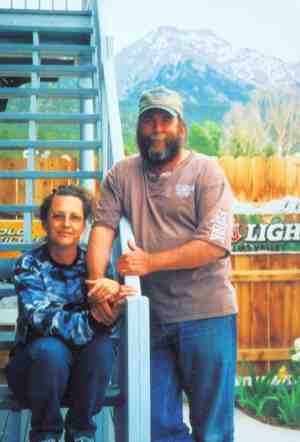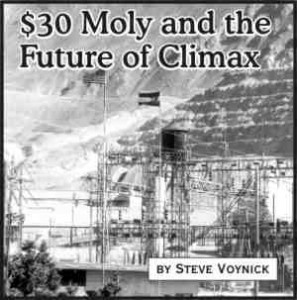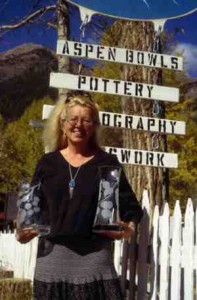Article by Peter Anderson
Mountain Life – July 2005 – Colorado Central Magazine
I’VE ALWAYS THOUGHT THAT THE RATIO of bars to churches could tell you something about a community. Having lived for seven years in Utah, I must admit I get a little uneasy when the bars are heavily outnumbered. That said, I have since come to settle in Crestone, a town full of spiritual communities — including a few churches (Baptist, Episcopalian, and Catholic) and more Buddhists (almost every variety) per capita than any other mountain town I know of. Until recently, there were no watering holes here, unless you count the Desert Sage Restaurant which, as the name suggests, is really more of a restaurant than it is a bar. A year or so ago, that changed.
The idea that Crestone would soon have its first full-on bar (which also serves barbecue), had me wondering: Who would I find bellying up to the bar at the Silver Crest Palace? A multi-religious assortment of robed monks? Neo-rasta mountain hipsters? Old wave refugees from the 1960’s? Assorted misfits, mystics, and mountaineers? Maybe a couple of Crestone’s few old-timers? In a community that is at once eclectic, eccentric, and tolerant, and still in the process of inventing itself, I knew it would be an interesting crowd.
Mention of Crestone always invites the usual stereotypes: Crestone as crystal-gazing mecca; Crestone as refuge for UFO enthusiasts; Crestone as hippy haven. It’s not that these interests aren’t represented in a town where Shirley McClaine once planned to build a new age center, where some other self-proclaimed visionary once came hoping to build a giant pink pyramid, and where a day spent at the Saturday market near Shambala Coffeehouse may inspire 60s flashbacks. It’s just that this is also a community that opposed Shirley McClaine’s center as well as the infamous pink pyramid. Others in the community–artists, Buddhists, Baptists, rednecks, bikers, retirees, monks, firefighters, and contractors, to name a few–are never covered in a sound-bite take on Crestone.

Brief mention of Crestone may also flush out the latest rumors circulating about this town. Melanie Snider, who owns the Silver Crest Palace Bar & Barbecue with her husband Allen Lemasters, has heard them all. On more than one occasion, she has offered this reassurance to residents from other parts of the Valley: “No live human sacrifices are taking place in Crestone.” Though many cultures and traditions are represented here, neither Aztec sacrifices or cannibalism are among them.
Melanie Snider has known Crestone since the late 1960s when her family moved here from Alamosa. It doesn’t bother her that the Baca-Crestone community has grown from a population of 50 (mostly old-time locals and retirees) to a population of between one and two thousand (seekers-carpenters-monks-musicians- artists-Buddhists-Baptists-and on and on.) She is determined to maintain some of Crestone’s old-time mining-town feel while helping to shape the downtown area and offering locals and visitors of all sorts a gathering place. The Silver Crest Palace, across the street from the post office and the soon-to-be-constructed credit union, was built with Crestone’s mining past in mind, complete with false front, old-time balconies, and hitching posts out front (as well as a sign saying “Mind Your Pipes” for those parking Harleys instead of horses).
WILLIE MCDOWELL, one of the few old-timers I’ve met in Crestone, drops by The Silver Crest regularly for a hand-rolled smoke and a glass or two of Budweiser (into which he always likes to shake a little salt ). He told me that the bars his father knew in Crestone, back in the early 20th century, weren’t too far removed from the rough-and-tumble saloons of the 1880s. As writer William Kitteridge once said of a saloon up in Montana, things could get “mighty western in a hurry.”
It may be that echoes of those early days lingered long enough to inspire the anti-bar and dance hall ordinance that the Crestone Town Council passed prior to the town’s resurgence in the 1970s. When Melanie’s family moved to Crestone in the late 1960s and opened a liquor store, they realized pretty quickly, as customers lingered outside the store with a cold one or two, that their front porch had become a meeting place. Legally, that was okay as long as the liquor store was also a residence. But when the Sniders chose to live elsewhere, their store front gathering spot was no longer a legal place to linger. And that was part of the inspiration for Melanie Snider’s notion to build a tavern in Crestone’s growing downtown area.
When Snider and Lemasters began laying out the plan for the Silver Crest Palace, they knew that the anti-bar and dance hall ordinance would be a hurdle. They also knew that they had the support of the mayor and several town council members. When a proposal to discontinue the ordinance issue went before the resident voters of Crestone, it was rejected by one vote.
“That bothered me for about 30 seconds,” Snider said. “But I believe in a higher power and I had this strong sense that there was another way for us to go.” She also knew, from her research, that she had other legal options — applying for a restaurant and liquor license being one. So that’s what they ended up doing. When their application was approved, the partially-built Silver Crest Palace once again had a future as a restaurant and bar.
Establishing a liquor-serving establishment downtown was clearly a divisive issue in Crestone. Adding to the controversy was concern that Lemasters, who likes to ride his Harley, and Snider, who likes to ride with him, were intent on opening a biker bar. While Snider and Lemasters are more than happy to serve bikers (or anyone else as long as they are legal and respectful of other bar and restaurant customers), the consensus in town seems to be that the Silver Crest Palace is more of a neighborhood pub than it is a bar catering to any one crowd. The Crestone Charter School held a fund-raiser at the Silver Crest as has the Crestone Fire Department. Aspiring valley models recently put on a lingerie show there. Crestone and Moffat high schools held their proms at the Silver Crest this year. The live music — ranging from jazz, to acoustic, to rockabilly, to blues, to full-on rock and roll — has been as diverse as the Silver Crest clientele.
That doesn’t mean that they haven’t run into the usual barroom challenges, including that of having to “86” a few locals (some of whom are inevitably neighbors or friends in a small town like Crestone). On the other hand, they’re quick to point out that some of the most vocal opponents of the bar in Crestone have since become customers. “One person who didn’t much want the bar told me early on that he couldn’t imagine Crestone with a bar.” Lemasters said. “A while back he told me he couldn’t imagine Crestone without it.”
“We wanted to create a place for the community to meet and a place for people to play and listen to live music,” Melanie Snider says. “It’s turned out that we have so much local talent around here and around the valley, that this has become a place for musicians to show people what they can do. A couple of bands have gotten together here as a result.” Open mic nights have given musicians without a venue a place to hone their talents. A lively bluegrass jam on Wednesday nights evolved into O’Connor, Baker, and Ellis — a band that now plays gigs around the valley. The same is true for a local rock n’ roll band called Shoestring that plays the Silver Crest regularly now. The Peaceful Warriors, another local band known to play at the Silver Crest, just issued their first CD.
SO, ASIDE FROM a loyal clientele made up of all sorts of musicians, who hangs out at the Silver Crest? Over the last six months or so, I took on the job of doing a little first hand research to answer that question. (Somebody had to do it.) I’ve met more carpenters and contractors than space travelers, more barbecue lovers than vegetarians, and more rock and rollers than monks. I’ve seen well-attended poker nights. And I’ve seen spirited crowds watching the Broncos. In other words, what I’ve seen at the Silver Crest is not unlike the kind of crowd you might find in a lot of mountain town bars.

And yet there is something uniquely Crestonian about the place, though it’s hard to pin down. I’ve heard and participated in conversations that you likely wouldn’t hear, say, at Billy’s Bar in Hooper (although I once met a stonemason from Mosca at Billy’s, whose life dream is to build a pyramid). I’ve had conversations about the finer points of Tibetan Buddhist wisdom in the Silver Crest as well as the cultural contributions of Beats, Hippies, and the Punk Rock scene. And I’ve speculated on the true nature of love with a local filmmaker who is exploring that theme in a documentary. I’ve also talked sports, politics, bears, and fires.
So I don’t know that there’s any clear picture of the Silver Crest scene to offer up here. But I do think that Melanie Snider and Allen Lemasters are dead on when they suggest that the Silver Crest has been a place for many diverse elements in Crestone — Buddhist and Baptist, cowboy and hipster, monk and motorhead – to meet over beer and barbecue and to see beyond the stereotypes that can divide a diverse community (or maintain some of the tired stereotypes and preconceptions that don’t really take into account the full range of the community.)
IN MANY WAYS, Allen Lemasters and Melanie Snider are the ideal hosts for the mix of folks that turn up at the Silvercrest. Both, though not in any formal way, consider themselves spiritual. After growing up in a traditional west-of-the-Mississippi kind of family in Texas (“hats, boots, snap-down shirts, the whole deal” as he put it), he lived in a commune back in the 70s (“until I got tired of working my ass off while the other guys were sittin’ around the bean pot”). He knows the construction trade having worked as a contractor in Texas and now in Crestone for many years, and is happiest when he’s riding his Harley. Known for his love of music and support of musicians, as well as a free and generous hand behind the bar — “Melanie gets after me for that, ” he admits — he once weathered a rough time in his life reading all sorts of wisdom literature including, as he put it, “all those ‘Gita’ books.”
“It all boils down to one thing — some people call it karma,” Lemasters said. “What you put out there, comes back around.”
Melanie Snider is a salty, down-to-earth, tell-it- like-it-is kind of person who freely mentions her faith in a “higher power.” She also expresses her frustration with religious folk who are more concerned with their own particular “dogma and ritual” than they are with the common good. Her sense is that the Silver Crest Palace is a place where people of different persuasions can meet face to face, person to person, and talk past any social barriers or stereotypes over beer and barbecue.
As Lemasters puts it, “I don’t care who you’re talking about — rednecks and hippies, [Crestone] Charter School kids and Moffat high school kids, locals and people from out of town — there’s a lot of fear of the unknown other. What happens here — like when both Moffat and Crestone High School seniors had their prom [in the restaurant and a game room that includes pool, shuffleboard, darts] — is that you shoot a game of pool with the other guy and realize he’s not so bad after all.”
“We have to live with each other,” Melanie Snider says. “That’s what this place is all about.”
Peter Anderson continues his study of transcendence at the Silver Crest Bar and Barbecue in Crestone. He edits and publishes Pilgrimage Magazine, is the poetry editor for the Mountain Gazette, and the author of a collection of essays — First Church of the Higher Elevations: Mountains, Prayer, and Presence, to be published by Ghost Road Press (Denver; August 2005)



